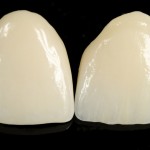
While laminate veneers have been used in dentistry since the 1930s porcelain veneers they did not begin to be widely used until the development of enamel etching and porcelain surface treatments. In recent years a number of ceramic material have been used and reviews have demonstrated good survival rates.
The aim of this review was to evaluate the survival rates of different preparations for ceramic laminate veneers with and without incisal coverage.
Methods
Searches were conducted in the PubMed and Cochrane Central Register of Controlled Trials databases with no limitations of language. Prospective and retrospective studies of ceramic laminate veneers with survival data or sufficient information to calculate survival were considered. Two reviewers selected studies and assessed risk of bias using the Newcastle-Ottawa Scale. Studies with ≥6 points were considered to have high methodological quality. Descriptive analysis and meta-analysis by using random effect models were performed based on the estimated survival of preparation designs for ceramic laminate veneer
Results
- 8 studies were included
- Only 1 study was considered to be at high risk of bias.
- Follow up periods ranged from 6mths to 21 years.
- Sample sizes ranged from 16-155 patients.
- Meta-regression showed no association between survival rate and follow-up time
- Cumulative survival rate for
- Incisal coverage (7 studies, N = 1186) =88% (95%CI; 80%–93%; I2 = 87,44%; p < 0.001).
- No incisal coverage (2 studies, N = 188) = 91% (95%CI; 81%–97%; I2 = 72,13; p = 0.0582).
- There was no significant difference in the odds of failure between those with and without incisal coverage OR=1.25(95% CI; 0.33–4.73; I2 = 65.3%; p = 0.0562).
Conclusions
The authors concluded:-
Irrespective of the preparation designs for placing ceramic laminate veneers with or without incisal coverage, high survival rates were revealed, providing evidence that both preparation designs are safe and effective options for the conservative treatment of anterior teeth. As regards the implications for future clinical research studies, it is necessary to conduct randomized clinical studies to compare preparations with and without incisal coverage and to provide clear descriptions of these preparation designs.
Comments
While previous reviews have demonstrated good survival rates for veneers this review focuses trying to identify differences between those with and without incisal coverage. This review has only used two databases compared with the Layton et al review, which searched 5 databases as well as hand searching a number of journals. Only a small number of relatively small studies were included involving just over 450 patients and 1772 veneers. As patients will have had multiple veneers placed the results will have been clustered and this should be taken into account. The reviewers highlight the type of preparation was not always well described. Only two in the included studies used no incisal coverage and all 3 meta-analysis demonstrated high level of heterogeneity so the reviews recommendation for well-conducted RCTs where preparations are clearly described is to be welcomed.
Links
Primary paper
Albanesi RB, Pigozzo MN, Sesma N, Laganá DC, Morimoto S. Incisal coverage or not in ceramic laminate veneers: A systematic review and meta-analysis. J Dent. 2016 Jun 18. pii: S0300-5712(16)30113-0. doi: 10.1016/j.jdent.2016.06.004. [Epub ahead of print] PubMed PMID: 27328640.
Other references
PROSPERO-Original review protocol
Morimoto S, Albanesi RB, Sesma N, Agra CM, Braga MM. Main Clinical Outcomes of Feldspathic Porcelain and Glass-Ceramic Laminate Veneers: A Systematic Review and Meta-Analysis of Survival and Complication Rates. Int J Prosthodont. 2016 Jan-Feb;29(1):38-49. doi: 10.11607/ijp.4315. Review. PubMed PMID: 26757327.
Layton DM, Clarke M, Walton TR. A systematic review and meta-analysis of the survival of feldspathic porcelain veneers over 5 and 10 years. Int J Prosthodont. 2012 Nov-Dec;25(6):590-603. Review. PubMed PMID: 23101039.

Incisal coverage for laminate veneers? https://t.co/ae7tkadAmd
Laminate veneers: incisal coverage or not? https://t.co/ae7tkadAmd
Laminate veneers with or without incisal coverage? https://t.co/ae7tkadAmd
Incisal coverage or not for laminate veneers? https://t.co/ae7tkadAmd
Laminate veneers survival rates similar with or without incisal coverage? https://t.co/ae7tkadAmd
Don’t miss: Laminate veneers: incisal coverage or not? https://t.co/ae7tkadAmd